- Chemical Name:Hdac-IN-1
- CAS No.:852475-26-4
- Molecular Formula:C17H15FN2O3
- Molecular Weight:314.316
- Hs Code.:
- European Community (EC) Number:685-051-2
- ChEMBL ID:CHEMBL191089
- DSSTox Substance ID:DTXSID40464187
- Nikkaji Number:J3.588.633H
- Wikidata:Q72488284
- Mol file:852475-26-4.mol
Synonyms:852475-26-4;HDAC-IN-1;MC 1568;1239610-44-6;MC-1568;(E)-3-[4-[(E)-3-(3-fluorophenyl)-3-oxoprop-1-enyl]-1-methylpyrrol-2-yl]-N-hydroxyprop-2-enamide;CHEMBL191089;(E)-3-(4-((E)-3-(3-fluorophenyl)-3-oxoprop-1-enyl)-1-methyl-1H-pyrrol-2-yl)-N-hydroxyacrylamide;(E)-3-(4-((E)-3-(3-fluorophenyl)-3-oxoprop-1-en-1-yl)-1-methyl-1H-pyrrol-2-yl)-N-hydroxyacrylamide;C17H15FN2O3;3-[5-(3-(3-Fluorophenyl)-3-oxoprope n-1-yl)-1-methyl-1H-pyrrol-2-yl]-N-hydroxy-2-prope namide;MLS006011094;SCHEMBL14974121;SCHEMBL14974122;CHEBI:95072;GTPL11121;DTXSID40464187;BCPP000170;BDBM50166164;HB1390;MFCD16875423;s1484;AKOS024457966;BCP9000898;CCG-267627;CS-1259;MC1568?;compound 2f [PMID: 15857140];NCGC00346534-07;3-[5-(3-(3-Fluorophenyl)-3-oxopropen-1-yl)-1-methyl-1h-pyrrol-2-yl]-n-hydroxy-2-propenamide;HY-15140;SMR004702882;SW219738-1;A12891;A906937;J-510633;3-(4-(3-(3-fluorophenyl)-3-oxoprop-1-enyl)-1-methyl-1H-pyrrol-2-yl)-N-hydroxyacrylamide;(2E)-3-[4-[(1E)-3-(3-Fluorophenyl)-3-oxo-1-propen-1-yl]-1-methyl-1H-pyrrol-2-yl]-N-hydroxy-2-propenamide;(E)-3-(4-((E)-3-(3-fluorophenyl)-3-oxoprop-1-enyl)-1-methyl-1Hpyrrol-2-yl)-N-hydroxyacrylamide;(E)-3-{4-[3-(3-Fluoro-phenyl)-3-oxo-propenyl]-1-methyl-1H-pyrrol-2-yl}-N-hydroxy-acrylamide



 Xn
Xn

